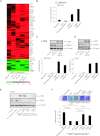Role of transcriptional corepressor CtBP1 in prostate cancer progression
- PMID: 23097625
- PMCID: PMC3479836
- DOI: 10.1593/neo.121192
Role of transcriptional corepressor CtBP1 in prostate cancer progression
Abstract
Transcriptional repressors and corepressors play a critical role in cellular homeostasis and are frequently altered in cancer. C-terminal binding protein 1 (CtBP1), a transcriptional corepressor that regulates the expression of tumor suppressors and genes involved in cell death, is known to play a role in multiple cancers. In this study, we observed the overexpression and mislocalization of CtBP1 in metastatic prostate cancer and demonstrated the functional significance of CtBP1 in prostate cancer progression. Transient and stable knockdown of CtBP1 in prostate cancer cells inhibited their proliferation and invasion. Expression profiling studies of prostate cancer cell lines revealed that multiple tumor suppressor genes are repressed by CtBP1. Furthermore, our studies indicate a role for CtBP1 in conferring radiation resistance to prostate cancer cell lines. In vivo studies using chicken chorioallantoic membrane assay, xenograft studies, and murine metastasis models suggested a role for CtBP1 in prostate tumor growth and metastasis. Taken together, our studies demonstrated that dysregulated expression of CtBP1 plays an important role in prostate cancer progression and may serve as a viable therapeutic target.
Figures





References
-
- Chinnadurai G. CtBP, an unconventional transcriptional corepressor in development and oncogenesis. Mol Cell. 2002;9:213–224. - PubMed
-
- Schaeper U, Boyd JM, Verma S, Uhlmann E, Subramanian T, Chinnadurai G. Molecular cloning and characterization of a cellular phosphoprotein that interacts with a conserved C-terminal domain of adenovirus E1A involved in negative modulation of oncogenic transformation. Proc Natl Acad Sci USA. 1995;92:10467–10471. - PMC - PubMed
-
- Kumar V, Carlson JE, Ohgi KA, Edwards TA, Rose DW, Escalante CR, Rosenfeld MG, Aggarwal AK. Transcription corepressor CtBP is an NAD+-regulated dehydrogenase. Mol Cell. 2002;10:857–869. - PubMed
-
- Balasubramanian P, Zhao LJ, Chinnadurai G. Nicotinamide adenine dinucleotide stimulates oligomerization, interaction with adenovirus E1A and an intrinsic dehydrogenase activity of CtBP. FEBS Lett. 2003;537:157–160. - PubMed
Publication types
MeSH terms
Substances
Grants and funding
LinkOut - more resources
Full Text Sources
Other Literature Sources
Medical
Molecular Biology Databases
Research Materials
